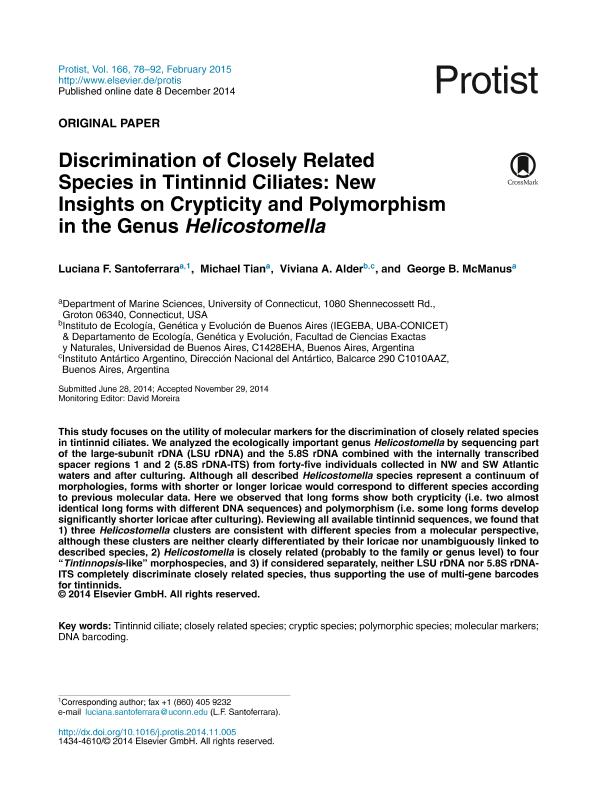Mostrar el registro sencillo del ítem
dc.contributor.author
Santoferrara, Luciana Fernanda

dc.contributor.author
Tian, Michael
dc.contributor.author
Alder, Viviana Andrea

dc.contributor.author
McManus, George B.
dc.date.available
2019-10-04T19:09:12Z
dc.date.issued
2015-02
dc.identifier.citation
Santoferrara, Luciana Fernanda; Tian, Michael; Alder, Viviana Andrea; McManus, George B.; Discrimination of closely related species in tintinnid ciliates: New insights on crypticity and polymorphism in the genus helicostomella; Elsevier Gmbh; Protist; 166; 1; 2-2015; 78-92
dc.identifier.issn
1434-4610
dc.identifier.uri
http://hdl.handle.net/11336/85271
dc.description.abstract
This study focuses on the utility of molecular markers for the discrimination of closely related species in tintinnid ciliates. We analyzed the ecologically important genus Helicostomella by sequencing part of the large-subunit rDNA (LSU rDNA) and the 5.8S rDNA combined with the internally transcribed spacer regions 1 and 2 (5.8S rDNA-ITS) from forty-five individuals collected in NW and SW Atlantic waters and after culturing. Although all described Helicostomella species represent a continuum of morphologies, forms with shorter or longer loricae would correspond to different species according to previous molecular data. Here we observed that long forms show both crypticity (i.e. two almost identical long forms with different DNA sequences) and polymorphism (i.e. some long forms develop significantly shorter loricae after culturing). Reviewing all available tintinnid sequences, we found that 1) three Helicostomella clusters are consistent with different species from a molecular perspective, although these clusters are neither clearly differentiated by their loricae nor unambiguously linked to described species, 2) Helicostomella is closely related (probably to the family or genus level) to four ". Tintinnopsis-like" morphospecies, and 3) if considered separately, neither LSU rDNA nor 5.8S rDNA-ITS completely discriminate closely related species, thus supporting the use of multi-gene barcodes for tintinnids.
dc.format
application/pdf
dc.language.iso
eng
dc.publisher
Elsevier Gmbh

dc.rights
info:eu-repo/semantics/openAccess
dc.rights.uri
https://creativecommons.org/licenses/by-nc-nd/2.5/ar/
dc.subject
CLOSELY RELATED SPECIES
dc.subject
CRYPTIC SPECIES
dc.subject
DNA BARCODING
dc.subject
MOLECULAR MARKERS
dc.subject
POLYMORPHIC SPECIES
dc.subject
TINTINNID CILIATE
dc.subject.classification
Biología Celular, Microbiología

dc.subject.classification
Ciencias Biológicas

dc.subject.classification
CIENCIAS NATURALES Y EXACTAS

dc.title
Discrimination of closely related species in tintinnid ciliates: New insights on crypticity and polymorphism in the genus helicostomella
dc.type
info:eu-repo/semantics/article
dc.type
info:ar-repo/semantics/artículo
dc.type
info:eu-repo/semantics/publishedVersion
dc.date.updated
2019-10-04T18:39:33Z
dc.journal.volume
166
dc.journal.number
1
dc.journal.pagination
78-92
dc.journal.pais
Alemania

dc.description.fil
Fil: Santoferrara, Luciana Fernanda. University of Connecticut; Estados Unidos. Consejo Nacional de Investigaciones Científicas y Técnicas; Argentina
dc.description.fil
Fil: Tian, Michael. University of Connecticut; Estados Unidos
dc.description.fil
Fil: Alder, Viviana Andrea. Consejo Nacional de Investigaciones Científicas y Técnicas. Oficina de Coordinación Administrativa Ciudad Universitaria. Instituto de Ecología, Genética y Evolución de Buenos Aires. Universidad de Buenos Aires. Facultad de Ciencias Exactas y Naturales. Instituto de Ecología, Genética y Evolución de Buenos Aires; Argentina. Ministerio de Relaciones Exteriores, Comercio Interno y Culto. Dirección Nacional del Antártico. Instituto Antártico Argentino; Argentina
dc.description.fil
Fil: McManus, George B.. University of Connecticut; Estados Unidos
dc.journal.title
Protist

dc.relation.alternativeid
info:eu-repo/semantics/altIdentifier/doi/http://dx.doi.org/10.1016/j.protis.2014.11.005
dc.relation.alternativeid
info:eu-repo/semantics/altIdentifier/url/https://www.sciencedirect.com/science/article/pii/S1434461014001217
Archivos asociados
